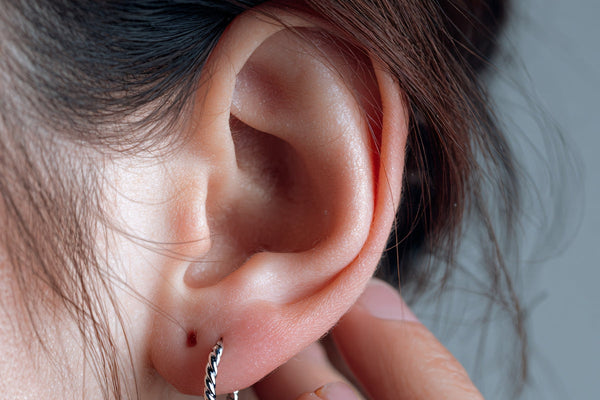
Airplane ear, also known as ear barotrauma, is a common condition that occurs when pressure changes around you affect the middle ear. It typically happens during air travel, particularly during take-off and landing, when the air pressure inside the cabin changes faster than your ears can adjust. These changes can cause discomfort, ear pain, or a temporary reduction in hearing.
Airplane ear is usually temporary and manageable, especially when you understand what’s happening and how to prevent it.
What is airplane ear (ear barotrauma)?
Airplane ear happens when there is an imbalance between the air pressure inside the middle ear and the air pressure outside the eardrum. The Eustachian tube - a small passage connecting the middle ear to the back of your nose and throat - normally equalises this pressure by opening and closing as you swallow or yawn. However, when it becomes blocked or cannot open properly, air pressure builds up behind the eardrum, causing it to stretch uncomfortably or even become damaged.
This pressure imbalance most often occurs:
· During air travel, especially take-off and landing when cabin pressure changes quickly
· While scuba diving, when descending or ascending in water
· When driving or hiking at high altitudes
If pressure cannot equalise, it may cause pain, muffled hearing, or in more severe cases, a small tear (perforation) in the eardrum. Though rare, severe barotrauma can lead to fluid leakage or temporary hearing loss.
What causes airplane ear?
The Eustachian tube plays a crucial role in maintaining pressure balance in your ears. When this tube doesn’t function properly, you are more likely to develop airplane ear. Common causes include:
· Colds, sinus infections, or allergies: These can cause swelling and congestion, making it harder for the Eustachian tube to open.
· Earwax build-up: Excess wax can trap air and interfere with pressure regulation.
· Rapid altitude changes: Flying, diving, or mountain travel can all create sudden pressure differences.
· Upper respiratory infections: Inflammation from infections can block airflow through the tube.
Sometimes, a combination of congestion and altitude changes can increase discomfort. If you already have an ear infection or fluid in the middle ear, airplane ear symptoms can be more noticeable.
Symptoms of airplane ear
Most people experience mild ear popping or pressure during flights. However, when pressure changes are extreme or the Eustachian tube is blocked, symptoms can be more uncomfortable. Common signs of airplane ear include:
· Ear pain or discomfort, often worse during descent
· Fullness or pressure in one or both ears
· Muffled hearing or a sensation of being underwater
· Popping or crackling sounds when swallowing or yawning
· Temporary hearing loss after landing
· Ringing or buzzing in the ear (tinnitus)
· In more severe cases, dizziness, nausea, or balance problems
Symptoms often ease as the pressure equalises. However, if they persist for more than a few hours or are accompanied by pain, discharge, or hearing loss, it could indicate barotrauma or another ear condition that requires attention.
How to prevent or relieve airplane ear
The best way to manage airplane ear is to help your Eustachian tubes stay open and functioning during pressure changes. Here are several effective ways to prevent or ease symptoms:
Before your flight:
· Avoid flying when you have a cold, sinus infection, or severe congestion. If possible, postpone travel until you’re feeling better.
· Use a decongestant spray or saline nasal rinse an hour before flying to clear nasal passages.
· Keep ears clean and free of wax build-up to allow pressure to equalise naturally.
During take-off and landing:
· Swallow, yawn, or chew gum regularly to encourage the Eustachian tube to open.
· Perform the Valsalva manoeuvre: Gently blow while pinching your nose and keeping your mouth closed. This helps push air into the middle ear to equalise pressure.
· Try filtered earplugs (flight earplugs) designed to slow the rate of pressure change.
· Stay awake during descent, as swallowing reflexes are reduced when sleeping.
For babies and children:
· Encourage feeding, sucking on a dummy, or drinking during take-off and landing to help equalise pressure naturally.
· If your child has a cold or infection, speak to a pharmacist or GP about suitable nasal drops before flying.
If discomfort persists after your flight, try swallowing, yawning, or gently performing the Valsalva manoeuvre again. Avoid inserting objects like cotton buds into your ears.
When to see a professional
Most cases of airplane ear clear up within a few hours, but you should see a hearing or ear care professional if you experience:
· Severe or persistent ear pain lasting more than 24-48 hours
· Hearing loss, tinnitus, or a feeling of fullness that does not improve
· Dizziness or balance problems after flying
· Fluid, blood, or discharge from the ear canal
These symptoms could be caused by barotrauma, infection, or a perforated eardrum. A professional examination ensures that you receive the right care quickly and safely.
At Leightons, our audiologists can examine your ears during a free hearing assessment using specialist equipment to check for wax, fluid, or infection. If necessary, we’ll refer you to an ENT specialist for further investigation or treatment.
How Leightons can help
At Leightons, we provide a range of services to help you maintain healthy, comfortable ears. Our ear health checks allow us to identify blockages, wax build-up, or signs of infection that could make you more prone to airplane ear.
Whether you’re a frequent flyer or simply want peace of mind before your next trip, our friendly audiologists can help you prevent discomfort and protect your hearing.
Book your free hearing assessment today and take the first step towards healthy, balanced ears.








